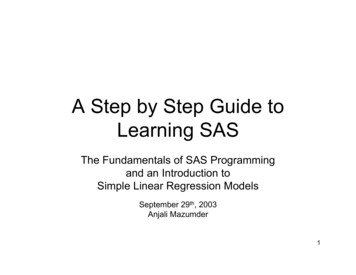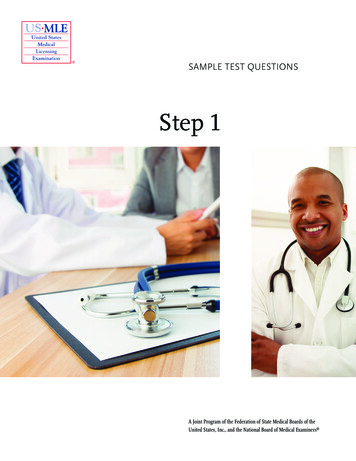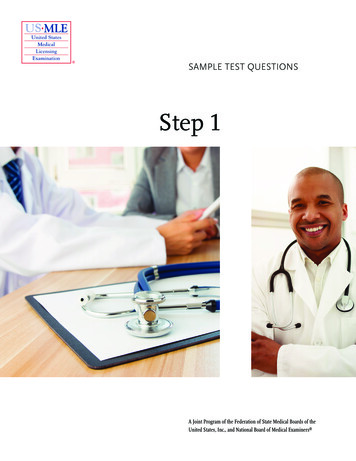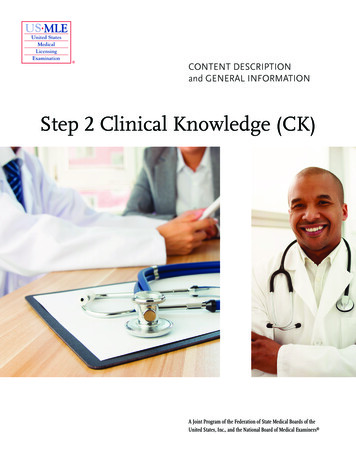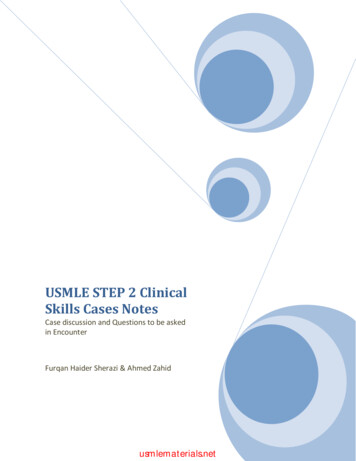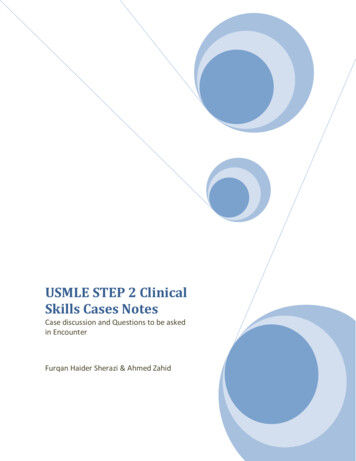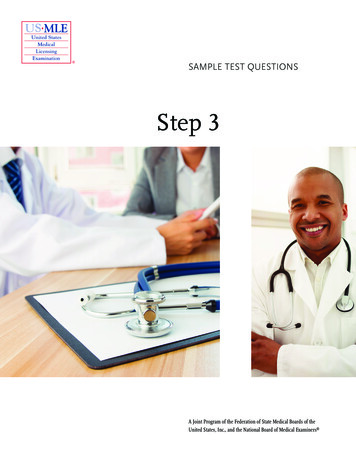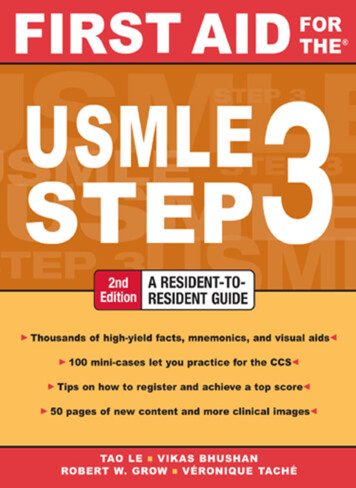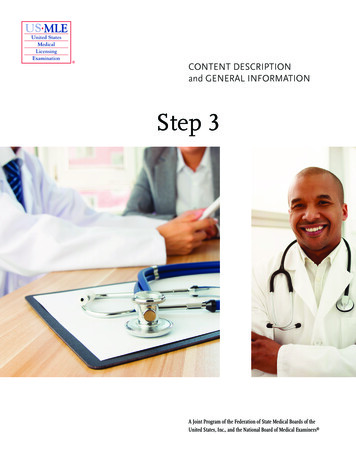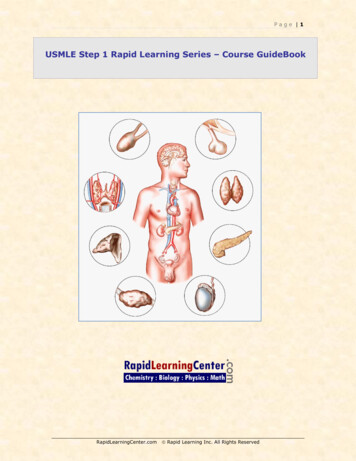
Transcription
Page 1USMLE Step 1 Rapid Learning Series – Course GuideBookRapidLearningCenter.com Rapid Learning Inc. All Rights Reserved
Page 2Table of Contents – Topical SummarySeries SummaryCore Unit #1 – Introduction to the USMLE ExamIn this core unit, you will review the USMLE Step 1 exam, including its format, contentcovered, and study tips and approaches. You will also be introduced to the structure andcontent of this series.Chapter 01: Introduction to the USMLE Exam Exam structure Content covered Sample types of questions Study tips and approaches Structure and content of tutorials in this seriesCore Unit #2 – Human Development and BehaviorIn this core unit, you will review human embryology, development and aging. Humanbehavior and psychiatry are also reviewed, as well as biostatistics.Chapter 02: Embryology Embryogenesis Congenital abnormalitiesChapter 03: Human Development and Aging Developmental milestones Childhood disorders Changes in the elderlyChapter 04: Behavioral Science and Patient Treatment Epidemiology Clinical trials Ethics Behavioral physiologyChapter 05: Psychiatry Psychology Personality disorders Psychiatric diseases Pharmaceutical treatment in psychiatryChapter 06: Biostatistics Study design Concepts of biostatisticsCore Unit #3 – Biochemistry and BiologyIn this core unit, you will review core concepts of biochemistry and biology, with an in-depthreview of genetics, microbiology and immunology topics relevant to the USMLE Step 1 exam.Chapter 07: Biochemistry Energy metabolism Metabolic pathways of small molecules Diseases linked to biochemical disordersRapidLearningCenter.com Rapid Learning Inc. All Rights Reserved
Page 3Chapter 08: Cell Biology Cellular structure and function Protein structure and function Cellular responses to environmental changesChapter 09: Genetics Gene expression Population genetics Clinical genetics Laboratory techniquesChapter 10: Microbiology Microbial classification Bacteria and bacterial diseases Viruses and viral diseases Fungi and fungal infections Parasites and parasitic diseases Systems microbiologyChapter 11: Immunology Immune system structure and function Normal and abnormal immune responses Therapeutics of the immune systemCore Unit #4 – Pathology and PharmacologyIn this core unit, you will review core concepts of pathology, histology and pharmacology.Chapter 12: Pathology and Oncology Inflammation Repair mechanisms NeoplasiaChapter 13: Histology Histology laboratory techniques Tissue histology Organ system histologyChapter 14: Pharmacology Pharmacodynamics Pharmacokinetics Pharmacology of the autonomic nervous system Toxicity and drug reactionsCore Unit #5 – Organ SystemsIn this core unit, you will learn about the normal and abnormal function of the majororgan systems. Tutorials include clinical notes on important diseases to know for theUSMLE Step 1 exam.Chapter 15: The Cardiovascular System Normal cardiac processes Abnormal cardiac processes Cardiovascular therapeuticsRapidLearningCenter.com Rapid Learning Inc. All Rights Reserved
Page 4Chapter 16: The Endocrine System Normal endocrine processes Abnormal endocrine processes Endocrine therapeuticsChapter 17: The Gastrointestinal System GI system anatomy GI system pathology GI system therapeutic principlesChapter 18: Hematology Normal hematopoietic processes Abnormal hematopoietic processes Hematopoietic therapeuticsChapter 19: Neurology Normal neural processes Abnormal neural processes Pharmacological treatment of neural abnormalitiesChapter 20: The Skin and Musculoskeletal Systems Anatomy and physiology Pathology PharmacologyChapter 21: The Renal System Normal renal processes Abnormal renal processes Renal system therapeuticsChapter 22: The Reproductive System Reproductive system structure Normal reproductive function Abnormal reproductive function Therapeutics of the reproductive systemChapter 23: The Respiratory System Normal respiratory processes Abnormal respiratory processes Respiratory therapeuticsChapter 24: Multisystem Processes Nutrients and nutrition Adaptation to changing environments Heavy metalsRapidLearningCenter.com Rapid Learning Inc. All Rights Reserved
Page 5Tutorial Series FeaturesThis tutorial series is a carefully selected collection of core concept topics in human medicinethat cover the essential concepts. It consists of three parts:USMLE Step 1 Concept Tutorials – 24 essential topicsProblem-Solving Drills – 24 practice setsCondensed Cheat Sheets – 24 super review sheetsTutorials Self-contained tutorials not an outline of information which would need to besupplemented by an instructor. Concept map showing inter-connections of new concepts in this tutorial and thosepreviously introduced. Definition slides introduce terms as they are needed. Visual representation of concepts. Conceptual explanation of important properties and problem solving techniques. A concise summary is given at the conclusion of the tutorial.Problem Solving DrillsEach tutorial has an accompanying Problem Set with 10 problems covering the materialpresented in the tutorial. The problem set affords the opportunity to practice what has beenlearned.Condensed Cheat SheetEach tutorial has a one-page cheat sheet that summarizes the key concepts andvocabularies and structures presented in the tutorial. Use the cheat sheet as a studyguide after completing the tutorial to re-enforce concepts and again before an exam.RapidLearningCenter.com Rapid Learning Inc. All Rights Reserved
Page 6Chapter by Chapter Content Guide01: Introduction to the USMLE ExamChapter Summary:The USMLE Step 1 exam covers a number of topics, including human development andbehavior; biochemistry and biology; pathology and pharmacology; and organ systems. Thefirst lecture in this series reviews the details of this exam. The tutorial also includes reviewsof common anatomical terms and the physical exam, to lay the groundwork for the remainingtutorials in the series.Tutorial Features:Specific Tutorial Features: Exam structure and strategies Content covered Sample types of questions Study tips and approaches Structure and content of tutorials in this series Review of anatomical terminology The physical examSeries Features: Concept map showing inter-connections of concepts. Sample USMLE Step 1 exam questions with full answers. Examples given throughout to illustrate how the concepts apply. A concise summary is given at the conclusion of the tutorial.Key Concepts: The USMLE exam structure, including topics and question typesStudy tips and approaches for the Step 1 examKey terminology in anatomyBasics of the physical examChapter Review:USMLE Step 1 Exam Step 1 Exam: assesses understanding and application of basic science concepts inmedicine, with an emphasis on principles and mechanisms underlying health, disease andtherapies Students are expected to be competent in a number of knowledge areas that can bedivided into two basic categories: general principles, which comprises 40-50% of thematerial, and organ system, which is the other 50-60% of materials. All questions in the USMLE Step 1 exam are multiple-choice. Questions on the USMLE fall into two categories: the one best answer format, and theclinical vignette. Never leave an answer blank – unanswered questions are automatically counted asincorrect answers, and you are not penalized further for providing an incorrect answer.Review of Anatomical TerminologyRapidLearningCenter.com Rapid Learning Inc. All Rights Reserved
Page 7 The human body can be divided into the transverse, coronal and median planes. It hasbilateral symmetry around the median plane.Directional terms describe the positions of body structures relative to other structures orlocations within the body. In humans, the superior or cranial end of the body is the head,while the inferior or caudal portion is the feet. Anterior refers to the front, and posteriorto the back. Lateral refers to the area away from the median plane, while medialdescribes a structure near the midline of the body. An intermediate structure is inbetween lateral and medial.The terms superficial and deep are relative to the surface of the body.Abduction is the movement of a limb away from the median plane of the body, whileadduction is movement towards the median plane.Adjusting the angle between two body parts may either be described as flexion, which is amovement that decreases the angle between two parts, or extension, which increases theangle between two body parts.The Physical ExamA physical exam consists of four parts: Inspection: refers to a thorough visual examination of the external features of thepatient, including body features, skin color, symmetry of appearance, gait, speechpatterns, frequency and volume of breaths during respiration, unusual odors or sounds. Palpation: areas of the body are felt to determine size, firmness and/or location. Percussion: a method of tapping on a surface to determine the underlying structure,such as with the thorax and abdomen. Auscultation: the clinical term for listening to the internal sounds of the body using astethoscope. This technique is used to examine sounds of the circulatory, respiratory andgastrointestinal tract systems.RapidLearningCenter.com Rapid Learning Inc. All Rights Reserved
Page 802: EmbryologyChapter Summary:Embryology is the study of early human development, or embryogenesis. A number ofcongenital abnormalities are possible during embryogenesis that significantly impact humanhealth. This tutorial reviews embryology topics commonly addressed during the USMLE Step1 exam, including fetal landmarks, early fetal development, developmental milestones ofmajor organ systems, and common congenital abnormalities. Helpful mnemonics areprovided throughout the tutorial to aid memorization of the material.Tutorial Features:Specific Tutorial Features: Embryogenesis Congenital abnormalitiesSeries Features: Concept map showing inter-connections of concepts. Sample USMLE Step 1 exam questions with full answers. Examples given throughout to illustrate how the concepts apply. A concise summary is given at the conclusion of the tutorial.Key Concepts: Embryogenesis has a number of common fetal development landmarksCongenital abnormalities may be due to exogenous or endogenous factorsChapter Review:EmbryogenesisFetal LandmarksDay 0 – sperm fertilizes egg forming zygote and beginning embryogenesis.Week 1 – zygote implants as a blastocyst.Week 2 – bilaminar disk forms as epiblast and hypoblast.Week 3 – gastrulation occurs, as well as formation of the primitive streak, notochord andneural plate.Weeks 3-8 – organogenesis occurs and the neural tube is formed. Fetus is extremelyvulnerable to teratogens during this period.Week 4 – heart starts beating and limb buds form.Week 8 – fetus begins to resemble a baby and fetal movement is present.Week 10 – male or female expression of genitalia is present.Early Development 2nd week – rule of 2‟s – 2 germ layers – the epiblast and hypoblast make up the bilaminardisk. 3rd week – rule of 3‟s – 3 germ layers of the gastrula are formed – the endoderm,mesoderm and ectoderm. 4th week – rule of 4‟s – 4 limb buds form, 4 heart chambers presentTwinning Monozygotic twins:RapidLearningCenter.com Rapid Learning Inc. All Rights Reserved
Page 91 zygote divides evenly to form 2 separate amniotic sacs with a single chorion andplacentao1 zgyote divides evenly and forms 2 separate amniotic sacs, 2 chorions and 2placentasDizygotic or fraternal twins: fertilization of independent ovao Placental Development The maternal component is made up of the decidual basalis which is derived from theendometrium. The fetal component is composed of 2 layersUmbilical Cord 2 umbilical arteries return deoxygenated blood back to the mother via the placenta. 1 umbilical vein provides oxygenated blood to the fetus from the mother via the placenta. The urachus carries urinary waste from the fetal bladder back to the mother via theplacenta.Development of the Interventricular SeptumStep 1 – the muscular ventricular septum forms leaving an opening between the left andright called the interventricular foramen.Step 2 – the aorticopulmonary septum forms to divide the truncus arteriousus into the aorticand pulmonary trunks.Step 3 – the muscular ventricular and aorticopulmonary septa join to form the membranousinterventricular septum, which closes the interventricular foramen.Development of the Interatrial SeptumStep 1 – the septum primum extends toward the endocardial cushions narrowing theforamen primum.Step 2 – the septum primum further develops leaving only perforations and forming theforamen secundum.Step 3 – the septum secundum begins to develop while the foramen secundum maintains theleft-to-right shunt.Step 4 – the septum secundum forms a permanent opening called the foramen ovale.Step 5 – the foramen secundum enlarges as the upper portion of the septum primumdegenerates.Step 6 – the remaining lower portion of the septum primum forms the valve of the foramenovale.Fetal Erythrpoiesis Yolk sac from 3-8 weeks Liver from 6-30 weeks Spleen from 9-28 weeks Bone marrow from 28 weeksFetal-Postnatal Derivatives The umbilical vein forms the ligamentum teres in the falciform ligament. The umbiLical arteries form the mediaL umbilical ligaments. The ductus Arteriosus forms the ligamentum Arteriousum. The ductus Venosus forms the ligamentum Venosum. The Foramen Ovale forms the Fossa Ovalis. The allaNtois or urachus forms the mediaN umbilical ligament. The Notochord forms the Nucleus pulposis of the intervertebral disks.RapidLearningCenter.com Rapid Learning Inc. All Rights Reserved
P a g e 10Congenital AbnormalitiesTeratogens: Thalidomide, ACE inhibitors, Iodide, Vitamin A, Warfarin, anticonvulsants, andx-rays, Fetal infections, Tobacco, Cocaine, AlcoholFetal Alcohol Syndrome: the
USMLE Step 1 Rapid Learning Series . Behavioral Science and Patient Treatment Epidemiology Clinical trials Ethics Behavioral physiology Chapter 05: Psychiatry Psychology Personality disorders Psychiatric diseases Pharmaceutical treatment in psychiatry Chapter 06: Biostatistics Study design Concepts of biostatistics Core Unit #3 – Biochemistry and Biology In this core unit, you will review .


